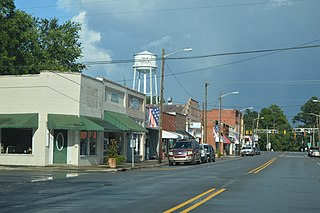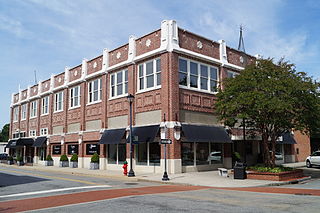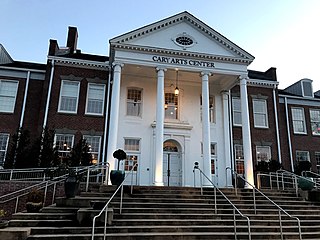Green Level is an unincorporated community in southwestern Wake County, North Carolina, United States. It was founded c. 1800 and is one of the best preserved crossroads communities in the county. Although historically connected to the town of Apex, Green Level now lies within the municipal jurisdiction of the town of Cary.

The La Grange Historic District is a national historic district located at La Grange, Lenoir County, North Carolina, United States. The district, encompassing 225 buildings and 1 structure, includes the historic commercial, residential, and industrial center of La Grange. The buildings include notable examples of Queen Anne and Bungalow/American Craftsman style architecture and date between the 1850s and the 1930s. Located in the district is the separately listed La Grange Presbyterian Church. Other notable buildings include the Sutton-Kinsey House, Walter Pace House, Sutton-Fields House, Colonel A. C. Davis House (1887), Rouse Banking Company Building (1908), LaGrange Elementary School, and the Hardy-Newsome Industrial Complex.

The New Hill Historic District is a national historic district located at New Hill, North Carolina, an unincorporated community in southwestern Wake County. The district encompasses the commercial and residential center and includes 2,820 acres (11.4 km2), 59 buildings, and one structure. The district developed between about 1860 and 1950, and includes notable examples of Colonial Revival and Tudor Revival style architecture. Notable buildings include the W. T. Roundy commercial complex, C.J. Bright's general merchandise store or New Hill Emporium, W. T. Roundy House, Duncan Lashley House, John Bright House, New Hill Baptist Church, Glass-Gardner House, and several farm complexes.

Faison Historic District is a national historic district located at Faison, Duplin County, North Carolina. The district encompasses 116 contributing buildings, 2 contributing structures, and 1 contributing object in the central business district and surrounding residential area of Faison. It includes industrial, residential, and commercial buildings with notable examples of Greek Revival, Queen Anne, and Italianate style architecture. Notable buildings include the Cates Pickle Company (1931), Moore Lee Thornton Store, C. S. Hines Store, Clifton's Service Station (1933), The Walter Livingston Hicks House, Faison Pharmacy, Witherington Building (1915), Faison Depot (1888), Presbyterian Church (1918), Elias Faison House, Faison-Williams House (1853), and Witherington House (1880).
East Durham Historic District is a national historic district located at Durham, Durham County, North Carolina. The district encompasses 731 contributing buildings and 1 contributing site in a predominantly residential section of Durham. The buildings primarily date between about 1890 and 1955 and include notable examples of Classical Revival and Queen Anne architecture. Notable buildings include the Holloway Street School (1928), East Durham Junior High School, Advent Christian Church (1920s), John Cheek House (1899), Community Groceries (1900), George Brown Grocery Store (1920), Seagroves Grocery Store (1915), and The People's Bank (1921).
Tarboro Historic District is a national historic district located near Tarboro, Edgecombe County, North Carolina. The district encompasses 364 contributing buildings in central Tarboro. It includes a variety of industrial, commercial, residential, and institutional buildings dating from the late-18th through early-20th centuries. Located in the district are the separately listed Tarboro Town Common, The Barracks, Redmond-Shackelford House, Pender Museum, Blount-Bridgers House, Coates-Walston House, Calvary Episcopal Church and Churchyard, and the Cotton Press complex. Other notable buildings include the Morris-Powell House, Porter House, U. S. Post Office (1914), Pippen House (1870s), Dancy-Battle-Bass Clark House, Holderness House, Howard Memorial Presbyterian Church (1908-1909), W. H. MacNair House (1913), Henry Cherry-George White House, Jones House (1870-1875), Tarboro Primitive Baptist Church, St. James Methodist Church (1916), Carolina Telephone & Telegraph (1912), Clark's Warehouse #1 and #2, Battle-Porter-Powell House, Gaskil1-Hussey House (1882), Cheshire-Nash House, and Norfleet Court (1858).

Louisburg Historic District is a national historic district located at Louisburg, Franklin County, North Carolina. The district encompasses 206 contributing buildings, 1 contributing site, 6 contributing structures, and 1 contributing object in residential sections of Louisburg included in the original 1779 town plan. It also includes a section of Louisburg College located on the old Town Commons. Dwellings date between about 1800 and the 1920s and include notable examples of popular architectural styles including Federal / Georgian, Italianate / Greek Revival, Queen Anne, Colonial Revival, Late Victorian, and Bungalow / American Craftsman. Located in the district and separately listed are the Fuller House, Williamson House, and Main Building, Louisburg College. Other notable buildings include the Shine-King House, Milner-Perry-Boddie-Dennis House, Dr. J.B. Clifton House, The Edgerton-Pruitt House, The Furgurson-Hicks House, Nicholson-Bickett-Taylor House, The Hughes-Watson-Wheless House, Bailey-Yarborough House, The Barrow House, The Neal-Webb House, The Milner-Williams-Person Place, Former Rectory-St. Paul's Episcopal Church, Hicks-Perry-Bland-Holmes House, Malcomb McKinne House First Baptist Church (1927), Louisburg United Methodist Church (1900), and Louisburg Baptist Church (1901-1904).

Summit Avenue Historic District, also known as the Dunleath Historic District and formally as the Charles B. Aycock Historic District, is a national historic district located at Greensboro, Guilford County, North Carolina. The district encompasses 226 contributing buildings in a middle- and upper-class residential section of Greensboro. The houses were largely built between the 1890s and 1930s and include notable examples of Queen Anne, Colonial Revival, American Foursquare, and Bungalow / American Craftsman-style architecture. The Sigmund Sternberger House (1926) is listed separately. Other notable buildings include the John C. Clapp House, Robert L. Potts House, William B. Vaught House, Edgar B. Jennette House, and the Charles B. Aycock School (1922) designed by Starrett & van Vleck.
Merge to Fairfield, Hyde County, North Carolina?

Nashville Historic District is a national historic district located at Nashville, Nash County, North Carolina. It encompasses 142 contributing buildings and 3 contributing structures in the rural county seat of Nashville. The buildings primarily date between 1890 and 1930, and include notable examples of Greek Revival, Italianate, Queen Anne, Colonial Revival, and Classical Revival style architecture. Located in the district are the separately listed Bissette-Cooley House and Nash County Courthouse. Other notable buildings include the Graphic Building, Baldy Batchelor Livery Stable, Weldon's Department Store (1913), Ricks-Strickland House (1890s), Squire Harper House (1868), two metal-veneered "Lustron houses," Neville-Strickland House (1907), Primitive Baptist Church, First Methodist Church (1923), and former Baptist Church.

Jackson Historic District is a national historic district located at Jackson, Northampton County, North Carolina. The district encompasses 168 contributing buildings, 2 contributing sites, 1 contributing structure, and 2 contributing objects in the central business district and surrounding residential sections of Jackson. The district developed between about 1825 and 1953 and includes notable examples of Federal and Greek Revival style architecture. Located in the district are the separately listed Amis-Bragg House, Church of the Saviour and Cemetery, and Northampton County Courthouse Square. Other notable contributing resources include Lewis Drug Store (1930), Kennedy's Five Cents to Five Dollars Store, Bank of Northampton (1928), Bowers Hardware Store, Atlas Oil Company Building, Farmer's Cotton Gin Complex, Faison House, Saint Catherine's Hall (1848), Judge Robert Peebles House (1890s), Selden-Boone House, Jackson Baptist Church (1881), and Jackson United Methodist Church (1937).

Greenville Commercial Historic District is a national historic district located at Greenville, Pitt County, North Carolina. The district encompasses 51 contributing buildings in the central business district of Greenville. It includes buildings dated from about 1914 to 1952 and notable examples of Greek Revival and Queen Anne style architecture. Located in the district and listed separately are the Pitt County Courthouse (1911) by Milburn, Heister & Company and U.S. Post Office (1913). Other notable buildings include the Proctor Hotel (1911), Montgomery Ward Department Store (1929), Dail-Hodges Building (1919), Blount Building (1924), Greenville Bank and Trust, Smith Electric Building, Greenville Municipal Building (1929) designed by Benton & Benton, Blount-Harvey Department Store (1923), White's Theater (1914), Charles Greene House (1860), and the Robert Lee Humber House (1895).

Farmville Historic District is a national historic district located at Farmville, Pitt County, North Carolina. The district encompasses 330 contributing buildings, 1 contributing site, and 2 contributing structures in the central business district and surrounding residential sections of Farmville. It includes buildings dated from about 1860 to 1942 and notable examples of Colonial Revival, Classical Revival, and Queen Anne style architecture. Notable buildings include the James W. May House, Fields-Rasberry House, Dr. David Morrill House, Warren Parker House, Nannie Smith House, First Christian Church (1910), Emmanuel Episcopal Church (1920), St. Elizabeth Catholic Church, Municipal Building (1928) possibly designed by Benton & Benton, Bank of Farmville (1921) designed by Benton & Benton, Pollard Auto Company Building, Paramount Theatre (1930s), J. Y. Monk Tobacco Warehouse, and East Carolina Railway Office and Freight Station.

Leaksville Commercial Historic District is a national historic district located at Eden, Rockingham County, North Carolina. It encompasses 12 contributing buildings in the central business district of the town of Eden. It includes buildings dated between about 1885 and 1939, and notable examples of Greek Revival, Classical Revival, and Colonial Revival style architecture. Notable buildings include a house built about 1840, the Realty Building (1924-1925), Leaksville Mercantile Building, Carter-Moir Hardware/Smith-Lane Store, the Fagg-King Building, Mitchell's Drug Store (1936), DeHart Building (1938), and United States Post Office (1939) designed by architect Louis A. Simon and built as a Works Progress Administration project.

Salisbury Historic District is a national historic district located at Salisbury, Rowan County, North Carolina. The district encompasses 348 contributing buildings and 1 contributing site in the central business district and surrounding residential sections of Salisbury. It includes notable examples of Late Victorian, Colonial Revival, and Bungalow / American Craftsman style architecture. Located in the district are the separately listed Maxwell Chambers House, McNeely-Strachan House, Archibald Henderson Law Office, and the former Rowan County Courthouse. Other notable buildings include the tower of the former First Presbyterian Church (1891-1893), Rowan County Courthouse (1914), Conrad Brem House, Kluttz's Drug Store, Bell Building, Washington Building, Grubb-Wallace Building, Hedrick Block, Empire Hotel, St. Luke's Episcopal Church (1827-1828), Soldiers Memorial A.M.E. Zion Church (1910-1913), U.S. Post Office and Courthouse (1909), City Hall (1926), Salisbury Fire House and City Building (1897).

Mount Airy Historic District is a national historic district located at Mount Airy, Surry County, North Carolina. The district encompasses 187 contributing buildings in the central business district and surrounding industrial and residential sections of Mount Airy. They were primarily built between about 1880 and 1930 and include notable examples of Late Victorian and Bungalow / American Craftsman architecture. Located in the district are the separately listed W. F. Carter House and Trinity Episcopal Church. Other notable buildings include the Abram Haywood Merritt House (1902), William A. Estes House, Thomas Fawcett House, J. D. Sargent House (1919), Campbell A. Baird House (1913), T. Benton Ashby House, First Baptist Church (1906-1912), Mount Airy Friends (1904), Presbyterian Church (1907-1914), Merritt Building, Banner Building (1906), Prather Block, Midkiff Hardware Store, Welch Block, West Drug Store, Belk's Building, (former) Workman's Federal Savings and Loan, (former) First National Bank (1893), Bank of Mount Airy (1923), U.S. Post Office (1932-1933), and the Sparger Brothers Tobacco Factory.

The Waxhaw Historic District is a national historic district located at Waxhaw, Union County, North Carolina. It encompasses 93 contributing buildings, 3 contributing structures, and 1 contributing object in the central business district and surrounding residential sections of Waxhaw. The district developed between about 1888 and 1940 and includes notable examples of Commercial Style, Queen Anne, and Bungalow / American Craftsman style architecture. Notable buildings include the former Post Office (1905), Harris's store, Tyson Store, A.W. Heath Co. Mill (1905), R.J. Belk Company Store, A.W. Heath Company Stores, Weir Building, Plyler Building, Farmer's Ginning & Trading Company, McDonald Hotel (1912), Waxhaw Presbyterian Church (1929), Duncan McDonald House, and Ralph J. Belk House.

Cary Historic District is a national historic district located at Cary, Wake County, North Carolina. The district encompasses 39 contributing buildings in a predominantly residential section of Cary. The district developed between about 1890 and 1945, and includes notable examples of Queen Anne and Bungalow / American Craftsman style architecture. Notable buildings include the former Cary High School built in 1939 by the Works Progress Administration, Esther Ivey House, Captain Harrison P. Guess House, and Dr. John P. Hunter House.

Plymouth Historic District is a national historic district located at Creswell, Washington County, North Carolina.
Elm City Municipal Historic District is a national historic district located at Elm City, Wilson County, North Carolina. It encompasses 85 contributing buildings in the railroad town of Lucama. The district developed between about 1873 to 1930 and includes notable examples of Classical Revival, Early Commercial, and Victorian style architecture. Notable buildings include the Batts & Williams Store (1884), G. A. Barnes Store (1912), Dawes Building (1914), Elm City Bank (1920s), Holden House, A. C. Dixon House, G. A. Barnes House, W. G. Sharpe House, Dr. Robert Putney, Sr., House, and L. C. Cobb House (1927).


















